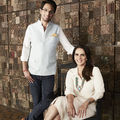Interviews
Athlete's foot fungus in the laundry basket?
25 Mar '10
3 min read
In Germany, there are approximately ten million people who suffer from athlete's foot. To be protected from infection, it is recommended that shoes are worn in particularly risky areas such as swimming pools, saunas or hotel rooms. However, little attention has been paid to the risk of infection that exists in people's homes. What happens if the socks of one family member who suffers from athlete's foot are kept together with other laundry in the laundry basket and washing machine?
Researchers from the Institute for Hygiene and Biotechnology at the Hohenstein Institute in Boennigheim took a closer look at this issue. The result: where contaminated articles of clothing are stored with other pieces of clothing, there is a possibility that fungus spores can be transferred from one textile to another. Lower washing temperatures in domestic washing machines are not sufficient to ensure the reliable and effective removal of skin fungi. Only laundry washed at 60°C did not contain any verifiable fungus spores on the tested textile material.
For their tests, Hohenstein researchers used a very sensitive germ measurement method, which radioactively marks the athlete's foot fungus, making it possible to verify individual spores in a matter of minutes. Following the washing cycles, it was possible to precisely detect fungus spores on individual textiles or in rinsing water. In cooperation with the industry, Hohenstein researchers are currently using this new method to develop a new anti-athlete's foot sock for the purpose of providing relief from this widespread disease in the foreseeable future.
The red and flaky areas on the skin, which are associated with athlete's foot and a strong itching or burning sensation, are very uncomfortable and painful. The infection is caused by specific skin fungi, so-called dermatophytes – mainly the Trichophyton rubrum fungus – which can form resistant spores for its propagation. The spores like the warm and moist environment of the foot and can spread over the entire foot if left untreated. In the process, they flake off the skin and can be deposited in the fibres of the socks.
In order to assess the infection risk through infected textiles, the researches initially cultivated dermatophytes in artificial culture media, followed by a simulation of laundry storage in a typical household. In this way they tested whether fungus spores are transferred from contaminated to non-contaminated socks while stored in the laundry basket. Spores were applied to cotton swatches, placed in a "laundry basket" together with clean textiles and carefully agitated for one hour at room temperature. This was followed by testing for the presence of athlete's foot germs on the previously clean textiles. The clear result: for all tests, germs were transferred to the previously uncontaminated textiles. Therefore people suffering from athlete's foot should always store their socks separate from other textiles.
Researchers from the Institute for Hygiene and Biotechnology at the Hohenstein Institute in Boennigheim took a closer look at this issue. The result: where contaminated articles of clothing are stored with other pieces of clothing, there is a possibility that fungus spores can be transferred from one textile to another. Lower washing temperatures in domestic washing machines are not sufficient to ensure the reliable and effective removal of skin fungi. Only laundry washed at 60°C did not contain any verifiable fungus spores on the tested textile material.
For their tests, Hohenstein researchers used a very sensitive germ measurement method, which radioactively marks the athlete's foot fungus, making it possible to verify individual spores in a matter of minutes. Following the washing cycles, it was possible to precisely detect fungus spores on individual textiles or in rinsing water. In cooperation with the industry, Hohenstein researchers are currently using this new method to develop a new anti-athlete's foot sock for the purpose of providing relief from this widespread disease in the foreseeable future.
The red and flaky areas on the skin, which are associated with athlete's foot and a strong itching or burning sensation, are very uncomfortable and painful. The infection is caused by specific skin fungi, so-called dermatophytes – mainly the Trichophyton rubrum fungus – which can form resistant spores for its propagation. The spores like the warm and moist environment of the foot and can spread over the entire foot if left untreated. In the process, they flake off the skin and can be deposited in the fibres of the socks.
In order to assess the infection risk through infected textiles, the researches initially cultivated dermatophytes in artificial culture media, followed by a simulation of laundry storage in a typical household. In this way they tested whether fungus spores are transferred from contaminated to non-contaminated socks while stored in the laundry basket. Spores were applied to cotton swatches, placed in a "laundry basket" together with clean textiles and carefully agitated for one hour at room temperature. This was followed by testing for the presence of athlete's foot germs on the previously clean textiles. The clear result: for all tests, germs were transferred to the previously uncontaminated textiles. Therefore people suffering from athlete's foot should always store their socks separate from other textiles.
Popular News
Leave your Comments
Editor’s Pick
Cary Vaughan & Jenna Wilson
Label - ace&Jig
Anita Dongre & Yash Dongre
House of Anita Dongre Limited
































-Ltd..jpg?tr=w-120,h-60,c-at_max,cm-pad_resize,bg-ffffff)





.jpg?tr=w-120,h-60,c-at_max,cm-pad_resize,bg-ffffff)
.jpg?tr=w-120,h-60,c-at_max,cm-pad_resize,bg-ffffff)






